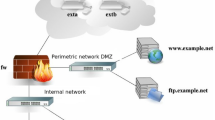Abstract
Cybersecurity education is an integral part of many undergraduate computer science curriculums. The draft ACM Computer Science Curricula 2013 recommends cybersecurity as a required body of knowledge for a typical computer science program. In the past few years, researchers and educators have developed various approaches and tools to implement laboratory projects for cybersecurity courses. Without doubt, cybersecurity education would be more effective, if we include hands-on activities to the relevant courses. This inclusion of hands-on activities can be achieved in various forms. Some institutions have the resources and expertise to set up physical laboratories for this purpose. Others use tools such as Second Life to create virtual classes and laboratories. This research reports our approach to hands-on activities for cybersecurity courses. In this approach, we use Kali Linux 2017.3 release pre-installed and preconfigured tools to create a set of laboratory projects. We also use VMware to setup virtual machine networks and then utilize security tools for hands-on part of our security courses. Finally, we report the details of the laboratory projects as well as their implementation.
Access this chapter
Tax calculation will be finalised at checkout
Purchases are for personal use only
Similar content being viewed by others
References
Asadoorian, P.: Enabling Nessus on Kali Linux - The Official Guide. http://www.tenable.com/blog/enabling-nessus-on-backtrack-5-the-official-guide
Buffer Overflow using Backtrack 5. http://www.hackerthreads.org/Topic-47252
Choi, Y.B., Lim, S, Oh, T.H.: Feasibility of virtual security laboratory for three tiered distance education. In: Proceedings of the 2010 SIGITE Conference (SIGITE 2010), pp. 53–57 (2010)
Du, W., Wang, R.: A suite of instructional laboratory projects for computer security education (SEED Project). ACM J. Educ. Resour. Comput. 8(1) (2008). Article 3
Edge, C., Stamey, J.: Security education on budget: “Getting the most Bang for Buck” with limited time and resources. In: InforSecCD 2010, 1–2 October 2010, Kennesaw, pp. 29–35 (2010)
Goodrich, M., Tamassia, R.: Introduction to Computer Security. Prentice Hall, Upper Saddle River (2011)
Google Hacking, for fun or profit. http://resources.infosecinstitute.com/google-hacking-for-fun-and-profit-i/
InfoSec Institute: Web Analysis, Vulnerability Assessment, and Exploitation using Backtrack 5. http://resources.infosecinstitute.com/web-analysis-bt-5/
Kali Linux. https://www.kali.org/downloads/
Louthan, G., Warren, R., Butler, M., John, H.: An offensive exercise for building network, systems and web security awareness. In: Proceedings of the 3rd International Conference on Cyber Security Experimentation and Test, Washington, DC, pp. 1–7. USENIX Association (2010)
Danseglio, M.: Adding a new non-root user in Kali Linux. https://www.interfacett.com/blogs/adding-a-new-non-root-user-in-kali-linux/
Nmap Security Scanner. http://nmap.org/
Ryoo, J., Techatassanasoontorn, A., Lee, D.: Security education using second life. IEEE Secur. Priv. 7(2), 71–74 (2009)
Sharma, S.K., Sefchek, J.: Teaching information systems security courses: a hands-on approach. J. Comput. Secur. 26(4), 290–299 (2007)
Staff, how to set up a limited user account in Windows. http://www.surfnetkids.com/tech/360/how-to-set-up-a-limited-user-account-in-windows/
Trabelsi, Z.: Switch’s CAM table poisoning attack: hands-on lab exercises for network security education. In: Proceedings of the Fourteenth Australian Computing Education (ACE 2012), vol. 123, pp. 113–120 (2012)
Windows Password Cracking Using Backtrack 5. http://hack-hour.blogspot.com/2012/02/windows-password-cracking-with.htmlirtual
VMware. https://www.vmware.com/products/workstation-player/workstation-player-evaluation.html. Accessed 12 Mar 2017
Howtoforge: Getting started command line encryption tools in Linux. https://www.howtoforge.com/tutorial/linux-commandline-encryption-tools/
Top 25 best Kali Linux Tools. https://linuxhint.com/top-25-best-kali-linux-tools/
Wafford, S.: Google Dorks. https://gist.github.com/stevenswafford/393c6ec7b5375d5e8cdc
Acknowledgment
The author would like to thank our department head, the Dean and the Provost of the University of North Georgia for their support my professional activities including this project.
Author information
Authors and Affiliations
Corresponding author
Editor information
Editors and Affiliations
Rights and permissions
Copyright information
© 2019 Springer Nature Switzerland AG
About this paper
Cite this paper
Ghafarian, A. (2019). Using Kali Linux Security Tools to Create Laboratory Projects for Cybersecurity Education. In: Arai, K., Bhatia, R., Kapoor, S. (eds) Proceedings of the Future Technologies Conference (FTC) 2018. FTC 2018. Advances in Intelligent Systems and Computing, vol 881. Springer, Cham. https://doi.org/10.1007/978-3-030-02683-7_25
Download citation
DOI: https://doi.org/10.1007/978-3-030-02683-7_25
Published:
Publisher Name: Springer, Cham
Print ISBN: 978-3-030-02682-0
Online ISBN: 978-3-030-02683-7
eBook Packages: Intelligent Technologies and RoboticsIntelligent Technologies and Robotics (R0)




